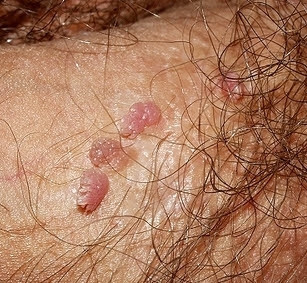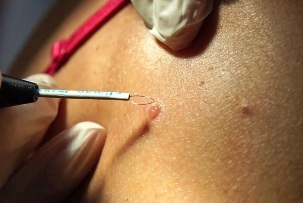
More often than not, people do not suspect that they have human papillomavirus (HPV) in their body. This is due to the fact that papillomavirus is usually present in latent form, suppressed by natural immunity. The problem arises when it is out of control and begins to actively manifest itself in the form of growth on different parts of the body. Men are more likely to experience viral effects than women, but for them, the effects can turn into serious problems in the form of papillomas on the penis.
Cause
Viral DNA enters the body through microcircles on the skin or mucous membranes. If a man’s immunity is weak, the first manifestations of HPV will appear a few months after infection.
Up to 80% of infections occur through sexual intercourse. Barrier contraception reduces the risk of infection, but does not eliminate it completely.
Other ways of infection:
- Household routes.The virus is transmitted along with the personal belongings of the infected person: clothing, hygiene items, etc. The risk of transmission increases if there is damage to the skin, even minor ones. This pathway is characterized by infection with low oncogenic virus types. They do not lead to serious health problems, but appear in the form of genital warts, papillomas and warts, which cause cosmetic defects.
- From mother to child.If the mother is infected with HPV during pregnancy and childbirth and give birth naturally, the baby will most likely be infected.
If a man has good immune defenses, the virus does not manifest itself and can last long in the body in latent form. Thus, it is not the infection with the virus itself that is harmful, but the weakening of the immune system, which leads to the activation of HPV.
There are a number of factors that influence the likelihood of strengthening the position of a virus:
- chronic diseases;
- hormone problems;
- contraceptives selected correctly or incompletely;
- virus infection;
- alcohol, smoking or long-term use of antibiotics;
- frequent stress.
All of these factors have a negative effect on the immune system. If in a man's life there is not one provoking factor, but several, this will lead to faster papillomavirus development.
Symptoms
Often, papillomas appear only externally, however, in some cases,nonspecific symptoms may occur:
- itching and burning during intercourse;
- pain when touching papilloma;
- accumulation of urine in the folds of the penis;
- unpleasant odor in the affected area.
In addition, neoplasms can grow and affect not only the penis area, but also appear in the anus and pubis.

Like papilloma
Penile papilloma is a small neoplasm. At first, she may appear alone, but without proper treatment, the number of papillomas increases. However, they can merge with each other.
This growth looks like fleshy or pink cauliflower inflorescences. Often they are localized in the foreskin, on the head and frenum. Less commonly, they are diagnosed in the urethra and scrotum. Papillomas can also appear as small white pimples that appear in long lines. This shape is special for localization in the restraint area.
One of the manifestations of HPV is Buschke-Levenshtein warts. It is distinguished by its rapid growth, remarkable size and resistance to various types of treatment. Its appearance is due to several papillomas and warts present, which merge and form a large lesion area. The presence of Buschke-Levenshtein condyloma is dangerous because the cells it modifies can easily develop into cancer.
Which doctor to contact
As a rule, urologists deal with the diagnosis of papilloma in men. You can also seek advice from a dermatovenerologist or proctologist if you have genital warts in the anal area. However, papillomas are usually referred to a surgeon for removal. Overall, the diagnosis occurs in several stages:
- Urologists examine and interview patients.Oral questions are needed to assess the patient's lifestyle and determine the cause of the viral infection. Visual examination involves not only assessing the condition of the penis, but also nearby organs - scrotum, anal area. This is necessary to complete the picture of the localization of the virus.
- Smear urethra.Determines the presence of various sexually transmitted diseases.
- PCR.This analysis shows not only the presence of HPV in the body, but also most likely to determine its type.
- Meatoscopy.This procedure is an examination of the urethra if the papillomavirus has infected the frenum.
- After removal of the papilloma, the doctor may order a biopsyto assess the condition of the removed tumor. This is necessary to rule out the risk of getting cancer and ensuring that the papilloma is benign.
In this case, it is advisable to conduct a survey of both partners. Usually a woman is also infected with one type of papillomavirus. If only one man was treated, he would most likely get sick after a while.
Why is papilloma dangerous
Human papillomavirus is often accompanied by other related diseases. The appearance of papilloma in the glans penis area contributes to the accumulation of urine in the folds. This creates conditions for the emergence and growth of various microorganisms, which in turn leads to infection. They can cause erosion around the papilloma, and also contribute to inflammation of the urethra and testicles. The disease is characterized by problems with urination, pain and high fever.
Another danger is trauma to the neoplasm, which causes bleeding. This is due to the fact that many blood vessels form around the papilloma, which supplies it with blood. Even minor damage can lead to infection due to injury.
Also, neoplasms can rub while moving, causing male pain and discomfort.
HPV and cancer
When new viruses begin to spread, neoplasms are sporadic and benign. Without treatment, they grow and merge with each other. Over time, cells degenerate into malignant cells.The risk of cancer is very high if a man is infected with a highly oncogenic virus - 16 or 18.
Papilloma treatment
HPV treatment involves not only eliminating its external manifestations, but also strengthening the immune system, which should block viral manifestations.Immunostimulatory drugs are used to maintain immunity.
As an antiviral drug, ointments that suppress viral growth and eliminate small growths are effective. It does not always overcome the task of removal completely, but prevents the emergence of new growth. Antiviral ointment is prescribed to stimulate immunity. The ointment does not remove the papilloma, but encourages the activation of cells of the immune system, which stops its growth and development.

Removal method
There are several ways to get rid of emerging new growth:
- Laser removal.Papilloma is exposed to laser beam, which burns the growth completely. A crust is formed in this place, which subsides after a few weeks. This method is considered effective due to the absence of relapse. Removal is performed under anesthesia. No bleeding, no scars or scars.
- Cryod Crash.Papilloma is exposed to liquid nitrogen. It immediately freezes the desired area, the neoplasm on it collapses and dies. The disadvantage of this method is the inability to control the depth of the cryodestruction effect. At the site of the papilloma removed, a crust is also left, which disappears after a few seconds.
- Radiosurgeri.The principle of this method is similar to laser removal. Radio waves do not leave scars and scars, and the procedure is preceded by initial anesthesia with a special spray. After that there are no complications, and the body recovers quickly.
- Electrocoagulation.Growth is influenced by electric current, which causes the foot to disappear, after which the papilloma disappears. Shallow anesthesia may be given if necessary. This procedure takes a few minutes, is very extensive and affordable. But this method is able to leave scars after healing.
- Surgical intervention.It is used in rare cases when the tumor becomes too large. It is performed under anesthesia, it has a long healing and trauma. The method is good because it allows you to take care of the growth produced for histological examination.
The cost of each method depends on the complexity of the work, the size and number of papillomas to be removed.
Before choosing a method, consult a doctor. He or she will tell you what is best to use in your situation, telling you in detail how the procedure was performed. Also, after removal of the neoplasm, it is recommended to take material for histology. This is necessary to determine whether the process of degeneration of benign neoplasms into malignant has begun. This method will help detect early cell changes and prevent the spread of cancer.















































































